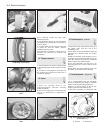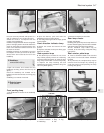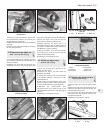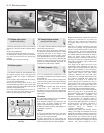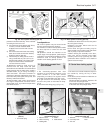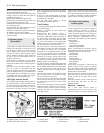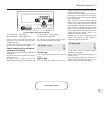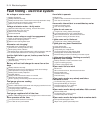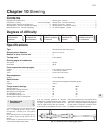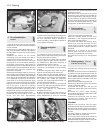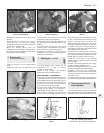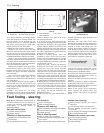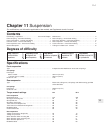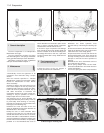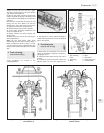
9•14 Electrical system
Fault finding - electrical system
No voltage at starter motor
ⅥⅥ Battery discharged
ⅥⅥ Battery defective internally
ⅥⅥ Battery terminals loose or earth lead not securely attached to body
ⅥⅥ Loose or broken connections in starter motor circuit
ⅥⅥ Starter motor switch or solenoid faulty
Voltage at starter motor - faulty motor
ⅥⅥ Starter brushes badly worn, sticking, or brush wires loose
ⅥⅥ Commutator dirty, worn or burnt
ⅥⅥ Starter motor armature faulty
ⅥⅥ Field coils earthed
Starter motor noisy or rough in engagement
ⅥⅥ Pinion or flywheel gear teeth broken or worn
ⅥⅥ Starter drive main spring broken
ⅥⅥ Starter motor retaining bolts loose
Alternator not charging*
ⅥⅥ Drivebelt loose and slipping, or broken
ⅥⅥ Brushes worn, sticking, broken or dirty
ⅥⅥ Brush springs weak or broken
* If all appears to be well but the alternator is still not charging, take the
car to an automobile electrician for checking of the alternator
Ignition light fails to go out, battery runs flat in a
few days
ⅥⅥ Drivebelt loose and slipping, or broken
ⅥⅥ Alternator faulty
Battery will not hold charge for more than a few
days
ⅥⅥ Battery defective internally
ⅥⅥ Electrolyte level too low or electrolyte too weak due to leakage
ⅥⅥ Plate separators no longer fully effective
ⅥⅥ Battery plates severely sulphated
ⅥⅥ Drivebelt slipping
ⅥⅥ Battery terminal connections loose or corroded
ⅥⅥ Alternator not charging properly
ⅥⅥ Short in lighting circuit causing continual battery drain
Fuel gauge gives no reading
ⅥⅥ Fuel tank empty!
ⅥⅥ Electric cable between tank sender unit and gauge earthed or loose
ⅥⅥ Fuel gauge case not earthed
ⅥⅥ Fuel gauge supply cable interrupted
ⅥⅥ Fuel gauge unit broken
Fuel gauge registers full all the time
ⅥⅥ Electric cable between tank unit and gauge broken or disconnected
Horn operates all the time
ⅥⅥ Horn push either earthed or stuck down
ⅥⅥ Horn cable to horn push earthed
Horn fails to operate
ⅥⅥ Blown fuse
ⅥⅥ Cable or cable connection loose, broken or disconnected
ⅥⅥ Horn has an internal fault
Horn emits intermittent or unsatisfactory noise
ⅥⅥ Cable connections loose
ⅥⅥ Horn incorrectly adjusted
Lights do not come on
ⅥⅥ If engine not running, battery discharged
ⅥⅥ Light bulb filament burnt out or bulbs broken
ⅥⅥ Wire connections loose, disconnected or broken
ⅥⅥ Light switch shorting or otherwise faulty
Lights come on but fade out
ⅥⅥ If engine not running, battery discharged
Lights give very poor illumination
ⅥⅥ Lamp glasses dirty
ⅥⅥ Reflector tarnished or dirty
ⅥⅥ Lamps badly out of adjustment
ⅥⅥ Incorrect bulb with too low wattage fitted
ⅥⅥ Existing bulbs old and badly discoloured
ⅥⅥ Electrical wiring too thin not allowing full current to pass
Lights work erratically, flashing on and off,
especially over bumps
ⅥⅥ Battery terminals or earth connections loose
ⅥⅥ Lights not earthing properly
ⅥⅥ Contacts in light switch faulty
Wiper motor fails to work
ⅥⅥ Blown fuse
ⅥⅥ Wire connections loose, disconnected or broken
ⅥⅥ Brushes badly worn
ⅥⅥ Armature worn or faulty
ⅥⅥ Field coils faulty
Wiper motor works very slowly and takes
excessive current
ⅥⅥ Commutator dirty, greasy or burnt
ⅥⅥ Drive spindle binding or damaged
ⅥⅥ Armature bearings dry or unaligned
ⅥⅥ Armature badly worn or faulty
Wiper motor works slowly and takes little current
ⅥⅥ Brushes badly worn
ⅥⅥ Commutator dirty, greasy or burnt
ⅥⅥ Armature badly worn or faulty
Wiper motor works but wiper blade remains static
ⅥⅥ Drive spindle damaged or worn
ⅥⅥ Wiper motor gearbox parts badly worn



